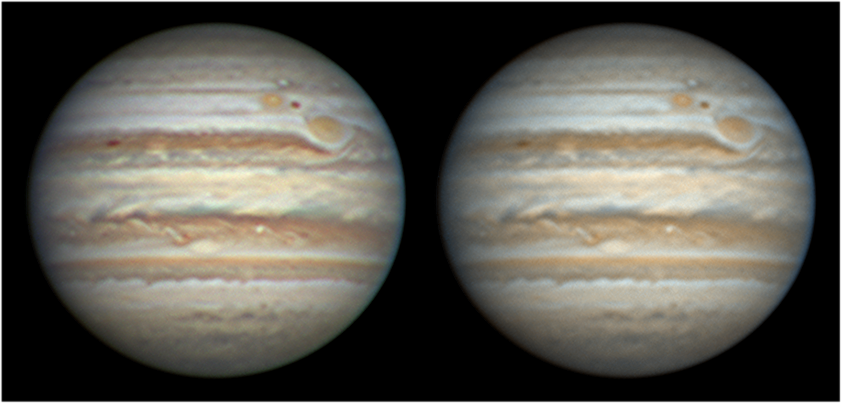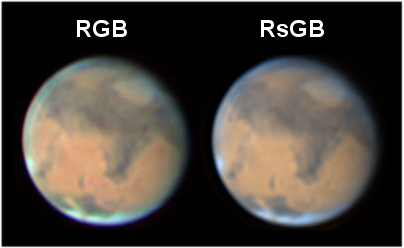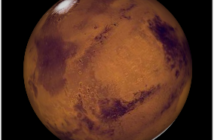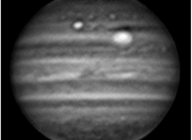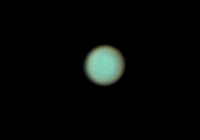Among the different techniques of imaging that we saw over the years, there was the use of a “synthetic” green image. Here is why it is less interesting than a true green image. This technique is quite outdated now and has never been really widely used, but this is a good opportunity to take a closer look at how color rendition is working.
A synthetic green image, why?
Many years ago, some imagers were using a purely computer-generated green frame by averaging red and blue frames. It is very simple to do: in any software, add R with B and divide by 2 the result. This produces a synthesized G frame that we’re going to call “sG” and the final color image is “RsGB”.
The advantage of this method was clear: by using only R and B, it was possible to get more raw frames during the same total time for those bands that are the most important. During ages were the CCD cameras were much slower than today, it could be welcomed to handle the rotation of planets.
At left: RGB image of Jupiter, at right, RsGB. The images are really close, even if there are some differences of hues already. Where do those differences come from… and is it worth taking care of it?
Another argument was to say that when imaging Mars it was not worth using the G filter because there is no green color on the planet (and we can consider this to be true 99 % of the time). However, color rendition is a bit more complicated…
No green on Mars, really?
Things are not correctly exposed. There is no green detail on Mars… but every details on Mars do reflect green light! (otherwise the planet would be invisible with the G filter!). For any detail (of any planet…) there is always a red component, a green and a blue one, and getting correct colors suppose that we respect as much as possible their respective importance. RGB filters are not meant to record the details that are of the same color: their role is to record the albedo of every detail in their transmission band, whatever is the value.
So now, the synth. G image, does it work? It does not work completely well. The reason is simple: saying that it is possible to average G from R and B suppose that the albedo of any detail in green light is always the average of the other two bands. But there is no rule for this in the reality. Let’s say that one object has an albedo of 60 % in red and 40 % in blue. With this method the albedo in green light is (60+40)/2 = 50 %. However in the reality, the G albedo of the object can take almost any independent value, 60, 80, 15… or 42,3 !
As a clear example here is at right a comparison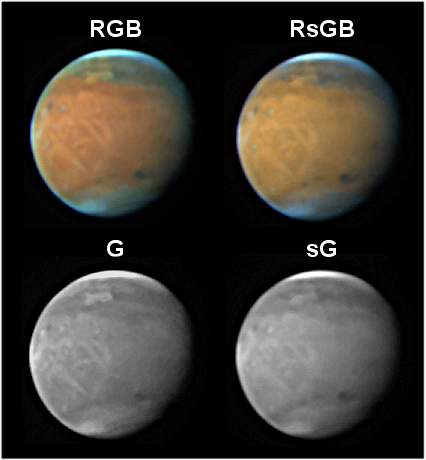
So here is the first disadvantage of a synthesized green: it reproduces a poorer range of colors on a planetary image.
I have done the same experience performed on an amateur image, taken by Jean-Jacques Poupeau on January 22nd, 2008. Again there is a small yellowish dust cloud, above Utopia (bottom left). As for the HST image, the color is not visible with the sG image.
What about resolution?
The second disadvantage is more subtle to notice on an amateur image. Most of the time, the resolution in blue light is poorer than in red light. But, the definition of the green image can be better than red, so in that case the RsGB image is going to lose resolution. This effect can be seen on the Jupiter image above.
Nowadays with our fast cameras and thanks to the derotation techniques of WinJupos, we have no reason anymore not to use a true green image!
You can also read this article by Damian Peach on a similar topic:

